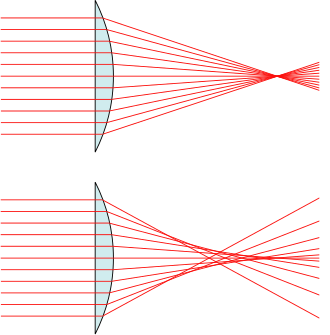AY Honors/Optics/Answer Key
1. Define and/or draw a diagram of the following:
a. Focal length
The distance from the lens (center of lens) or mirror to the focal point.
b. Positive lens
This type of lens creates a real image by converging the rays of light to a common focus.
c. Negative lens
This type of lens diverges the light or causes it to spread. It creates a virtual focal point that appears to be the location where the light is coming from.
d. Two kinds of distortion
- Barrel Distortion
- The Magnification decreases as you get farther from the center of the lens. This is the type of distortion in fisheye lens. It appears like the image has been mapped around a sphere.
- Pincushion Distortion
- The Magnification increases as you get farther from the center of the lens. This is the type of distortion is often seen in low quality telephoto lenses. It appears like the image has been pinched toward the middle.
e. Longitudinal color
Different colors of light are bent to varying degrees as they go though a medium such as glass. This effect is is called Chromatic Aberration. The affect is a longitudinal displacement (along the axis of the lens) of the focus.
Chromatic aberration is caused by the fact that different colors of light travel at different speeds through a medium such as glass. The amount of bend in the light as it travels from one medium to another is given by Snell's law:
- [math]\displaystyle{ \frac{\sin\theta_1}{\sin\theta_2} = \frac{velocity\ 1}{velocity\ 2} = \frac{n_2}{n_1} }[/math]
The bigger the difference in the velocities, the more bending takes place.
f. Lateral color
g. Spherical aberration

Lenses with surfaces that are spherically shaped are easier to manufacture, but they have a flaw that the light that travels through the lens near the center focuses at a different point than the light that travels through the lens near the edge.
Spherical mirrors will show the same aberration as spherical lenses, but it is fairly easy to parabolize a mirror and cause the focus to be at a single point. Non spherical lenses are difficult to manufacture, but modern computer controlled polishing machines are improving lens quality.
h. Achromatic lens
By using two lenses made of different materials we can minimize the amount of chromatic aberration that a lens creates. This principle is used in all high quality lenses to create a better image.
i. Refraction of light
Light is bent as it goes from one medium to another. The more difference there is in the two media, the greater the amount of refraction.
2. Explain how light behaves when it strikes or traverses water, oil, feldspar, and a mirror.
Water
When light travels though air and strikes water it is bent or refracted. This is caused by the difference between the speed of light through air and the speed of light through water.
Oil
When light strikes oil (or a soap bubble) it gets reflected twice. The first reflection occurs when light strikes the top surface of the oil, but not all of the light is reflected here. Some of the light penetrates the surface of the oil and is reflected from the bottom surface. This causes the light to undergo a phase shift. When the light emerges from the oil and is recombined with light reflected from the surface, some of the light frequencies are canceled, and others are reinforced. Which frequencies are canceled and which are reinforced depends on the angle at which they are viewed, and the viewing angle changes continuously over the surface of the oil. The effect is that one band of oil will appear yellow, another green, another yellow, etc. This is why you see a rainbow in a puddle of oil or on a soap bubble.







